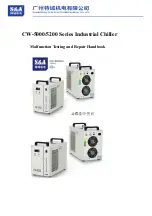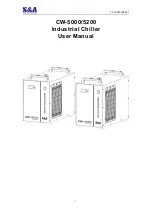
17/19EX
50/60 Hz
Centrifugal Liquid Chillers
with HFC-134a
Start-Up, Operation, and Maintenance Instructions
Manufacturer reserves the right to discontinue, or change at any time, specifications or designs without notice and
without incurring obligations.
PC 211 Catalog No. 531-715
9-95
Form 17/19EX-1SS
Replaces: 19EX-1SS
Copyright © Carrier Corporation 1995
Safety Considerations
Centrifugal liquid chillers are designed to provide safe and reliable service when
operated within design specifications. When operating this equipment, use good
judgement and safety precautions to avoid damage to equipment and property or injury
to personnel.
Be sure you understand and follow the procedures and safety precautions contained
in the machine instructions as well as those listed in this guide.
®
Summary of Contents for 17/19EX
Page 346: ...Figure 1 17 19EX Identification ...
Page 347: ...Figure 2 Typical 17EX Installation ...
Page 348: ...Figure 3 Typical 19EX Installation ...
Page 349: ...Figure 4 Refrigerant Motor Cooling and Oil Cooling Cycles ...
Page 350: ...v Figure 5 Hermetic Compressor Lubrication System EX Compressor Shown ...
Page 351: ...Figure 6 Open Drive 17 Series Lubrication Cycle ...
Page 355: ...Motor End View Figure 7 17EX Controls and Sensor Locations Figure 7 continued on next page ...
Page 356: ...Figure 7 17EX Controls and Sensor Locations ...
Page 359: ...Machine Rear View Figure 8 19EX Controls and Sensor Locations Figure 8 continued on next page ...
Page 360: ...Motor End View Figure 8 19EX Controls and Sensor Locations Figure 8 continued on next page ...
Page 361: ...Figure 8 19EX Controls and Sensor Locations ...
Page 362: ...Figure 9 Control Center Front View Shown with Options Module ...
Page 363: ...Figure 10 Control Sensors Temperature ...
Page 364: ...Figure 11 Control Sensors Pressure Transducer Typical ...
Page 365: ...Figure 12 Power Panel without Options Open Drive Machine Shown ...
Page 366: ...Figure 13 Power Panel with Options Hermetic Machine Shown ...
Page 367: ...Figure 14 LID Default Screen ...
Page 368: ...Figure 15 LID Service Screen ...
Page 369: ...Figure 16 17 19EX Menu Structure ...
Page 370: ...Figure 17 17 19EX Service Menu Structure ...
Page 371: ...Figure 18 Example of Point Status Screen Status01 ...
Page 372: ...Figure 19 Example of Time Schedule Operation Screen ...
Page 373: ...Figure 20 Example of Set Point Screen ...
Page 374: ...Figure 21 17 19EX Hot Gas Bypass Surge Prevention ...
Page 375: ...Figure 22 17 19EX with Default Metric Settings ...
Page 376: ...Figure 23 Example of Attach to Network Device Screen ...
Page 377: ...Figure 24 Example of Holiday Period Screen ...
Page 378: ...Figure 25 Control Sequence ...
Page 379: ...Figure 26 Typical Wet Bulb Type Vacuum Indicator ...
Page 380: ...Figure 27 Shipping Bolt on Open Drive Motor ...
Page 381: ...Figure 28 17 19EX Leak Test Procedures ...
Page 382: ...Figure 29 Dehydration Cold Trap ...
Page 383: ...Figure 30 Correct Motor Rotation ...
Page 384: ...Figure 31 Refrigeration Log ...
Page 386: ...Figure 32 Pumpout Arrangement and Valve Number Locations 12 ft Vessel Shown Continued ...
Page 387: ...Figure 33 Pumpout Unit Wiring Schematic 19EX Shown ...
Page 388: ...Figure 34 Optional Pumpout Compressor ...
Page 389: ...Figure 35 Electronic Vane Actuator Linkage ...
Page 390: ...Figure 36 Compressor Contact Seal Open Drive Machines ...
Page 391: ...Figure 37 Checking Preliminary Alignment ...
Page 392: ...Figure 38 Measuring Angular Misalignment in Elevation ...
Page 393: ...Figure 39 Measuring Angular Misalignment on Brackets ...
Page 394: ...Figure 40 Alignment Formula ...
Page 395: ...Figure 41 Adjusting Angular Misalignment in Plan ...
Page 396: ...Preparation Figure 42 Correcting Parallel Misalignment Figure 42 continued on next page ...
Page 397: ...Measurement Figure 42 Correcting Parallel Misalignment Figure 42 continued on next page ...
Page 398: ...Adjustment Figure 42 Correcting Parallel Misalignment ...
Page 400: ...To Check Parallel Alignment Figure 43 Alignment Check Assembled Coupling ...
Page 401: ...Figure 44 Removing the Oil Filter ...
Page 402: ...Figure 45 Typical Float Valve Arrangement ...
Page 403: ...Figure 46 Lifting Open Drive Motor ...
Page 404: ...Figure 47 Controls for Optional Pumpout Compressor ...
Page 405: ...Figure 48 Oil Differential Pressure Power Supply Module ...
Page 406: ...Figure 49 PSIO Module LED Locations ...
Page 407: ...Figure 50 LID Module Rear View and LED Locations ...
Page 408: ...Figure 51 Processor PSIO Module ...
Page 409: ...Figure 52 Starter Management Module SMM ...
Page 410: ...Switch Setting Options Module 1 Options Module 2 S1 S2 6 4 7 2 Figure 53 Options Module ...
Page 411: ...Figure 54 Model Number Nomenclature for Compressor Size See Figure 1 Also ...
Page 414: ...Figure 55 Open Drive Compressor Fits and Clearances Note See Table 17 for dimensions ...
Page 416: ...Figure 56 Hermetic Compressor Fits and Clearances ...
Page 418: ...Figure 57 Electronic PIC Controls Wiring Schematic Hermetic Machine ...
Page 420: ...Figure 58 Electronic PIC Controls Wiring Schematic Open Drive Machine ...
Page 422: ...Figure 59 Machine Power Panel Starter Assembly and Motor Wiring Schematic ...
Page 423: ...Figure 60 Hermetic Drive Power Panel with Water Cooled Oil Cooler ...
Page 424: ...Figure 61 Hermetic Drive Power Panel with Motor Cooling Solenoid ...
Page 425: ...Figure 62 Open Drive Power Panel ...


































